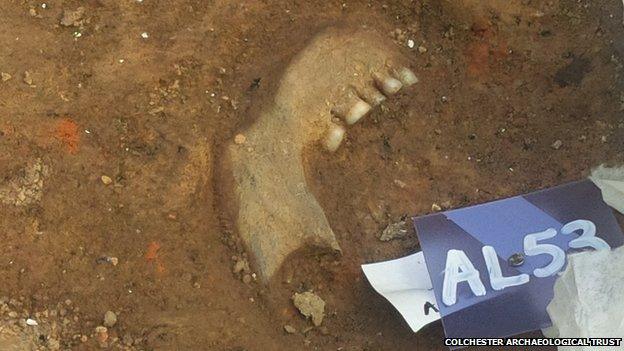Colchester Roman jewellery found hidden under shop
- Published
.jpg)
Roman jewellery described as being of "national importance" has been discovered during excavations at an Essex department store.
Gold and silver armlets, bracelets, rings and coins were found buried in the remains of a Roman house beneath Williams and Griffin in Colchester.
It is thought they were hidden by their wealthy owner in AD61, when Boudicca's British tribes burnt down the town.
Colchester Archaeological Trust said it was a "remarkable Roman collection".
The jewellery was found during renovation work at the shop, which is part of the Fenwick group and currently undergoing a £30m redevelopment.

In July a jaw and shin bones dating from the same period were found under the shop
Philip Crummy, the archaeological trust's director, said it was discovered three days before the six-month dig was scheduled to end.
'Two-day siege'
It was buried in a layer of red and black debris - the remains of burnt clay Roman walls - found under much of Colchester.
Three gold armlets, a silver chain necklace, two silver bracelets, a silver armlet, a small bag of coins and a small jewellery box containing two sets of gold earrings and four gold finger rings were unearthed by archaeologists.
The "quality" of the jewellery suggested its owner was a wealthy woman and had hidden the jewels to keep them safe from the enemy, Mr Crummy said.

Archaeologists have been excavating beneath the store as it is being redeveloped
"Boudicca and her army destroyed London and St Albans, though many of their inhabitants had time to escape. The townsfolk of Colchester were not so fortunate.
"They were not evacuated and endured a two-day siege before they were defeated."
The jewellery has been taken to a laboratory for further examination and cleaning.
In July Mr Crummy's team discovered human jaw and shin bones under the shop.
They are also believed to date from AD61 and were "likely to be the remains of people who died in buildings set on fire by the British as they overran the town", Mr Crummy said.
- Published7 July 2014

- Published14 December 2012

- Published31 October 2012
